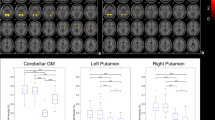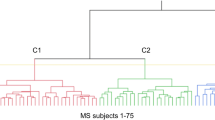Abstract
Objective
The variability of the severity and regional distribution of pathological process in basal ganglia (BG) and brainstem–cerebellar systems results in clinical heterogeneity and represents the motor subtype of multiple system atrophy (MSA). This study aimed to quantify spatial patterns of multimodal MRI abnormalities in BG and stem-CB regions and define structural MRI findings that correlate with clinical characteristics.
Methods
We simultaneously measured R2*, mean diffusivity (MD), and volume in the subcortical structures (BG, thalamus, brainstem–cerebellar regions) of 39 probable MSA and 22 control subjects. Principal component analysis (PCA) and structural equation modeling (SEM) were performed to show a model consisting of multiple inter-dependencies.
Results
Structural MRI alterations were found to be significantly interrelated within BG as well as brainstem–cerebellar regions in MSA patients. PCA extracted four factors: three factors reflected alterations in R2*, MD and volume of the BG region including the caudate nucleus, putamen, and pallidum, and the remaining one factor represented degenerative changes in MD and volume of stem-CB region. In SEM, a latent variable reflecting brainstem–cerebellar degeneration did not show a significant correlation with the other latent variables associated with BG degeneration. Putaminal MD values and a PCA-driven factor reflecting MD values in the BG showed a significant correlation with UPDRS and UMSARS scores.
Conclusion
Multimodal structural MRI abnormalities in MSA appear to be segregated into BG and stem-CB-related factors that can be associated with the clinical phenotype and motor severity.


Similar content being viewed by others
References
Wenning GK, Geser F, Krismer F, Seppi K, Duerr S, Doesch S et al (2013) The natural history of multiple system atrophy: a prospective European cohort study. Lancet Neurol 12:264–274
Gilman S, Wenning GK, Low PA, Brooks DJ, Mathias CJ, Trojanowski JQ et al (2008) Second consensus statement on the diagnosis of multiple system atrophy. Neurology 71:670–676
Schottlaender LV, Sailer A, Ahmed Z, Dickson DW, Houlden H, Ross OA (2017) Multiple system atrophy: clinical, genetics, and neuropathology. In: Schapira A, Wszolek Z, Dawson TM, Wood N (eds) Neurodegeneration, 1st edn. Wiley, Oxford, pp 58–71
Jellinger KA (2014) Neuropathology of multiple system atrophy: new thoughts about pathogenesis. Mov Disord 29:1720–1741
Ozawa T, Paviour D, Quinn NP, Josephs KA, Sangha H, Kilford L et al (2004) The spectrum of pathological involvement of the striatonigral and olivopontocerebellar systems in multiple system atrophy: clinicopathological correlations. Brain 127:2657–2671
Ozawa T, Tada M, Kakita A, Onodera O, Tada M, Ishihara T et al (2010) The phenotype spectrum of Japanese multiple system atrophy. J Neurol Neurosurg Psychiatry 81:1253–1255
Sitburana O, Ondo WG (2009) Brain magnetic resonance imaging (MRI) in parkinsonian disorders. Park Relat Disord 15:165–174
Barbagallo G, Sierra-Pena M, Nemmi F, Traon AP, Meissner WG, Rascol O et al (2016) Multimodal MRI assessment of nigro-striatal pathway in multiple system atrophy and Parkinson disease. Mov Disord 31:325–334
Blain CR, Barker GJ, Jarosz JM, Coyle NA, Landau S, Brown RG et al (2006) Measuring brain stem and cerebellar damage in parkinsonian syndromes using diffusion tensor MRI. Neurology 67:2199–2205
Lee JH, Han YH, Kang BM, Mun CW, Lee SJ, Baik SK (2013) Quantitative assessment of subcortical atrophy and iron content in progressive supranuclear palsy and parkinsonian variant of multiple system atrophy. J Neurol 260:2094–2101
Paviour DC, Thornton JS, Lees AJ, Jager HR (2007) Diffusion-weighted magnetic resonance imaging differentiates parkinsonian variant of multiple-system atrophy from progressive supranuclear palsy. Mov Disord 22:68–74
Lee MJ, Shin JH, Seoung JK, Lee JH, Yoon U, Oh JH et al (2016) Cognitive impairments associated with morphological changes in cortical and subcortical structures in multiple system atrophy of the cerebellar type. Eur J Neurol 23:92–100
Alexander-Bloch A, Giedd JN, Bullmore ET (2013) Imaging structural co-variance between human brain regions. Nat Rev Neurosci 14:322–336
Brenneis C, Egger K, Scherfler C, Seppi K, Schocke M, Poewe W et al (2007) Progression of brain atrophy in multiple system atrophy. A longitudinal VBM study. J Neurol 254:191–196
Lee JH, Kim TH, Mun CW, Kim TH, Han YH (2015) Progression of subcortical atrophy and iron deposition in multiple system atrophy: a comparison between clinical subtypes. J Neurol 262:1876–1882
Schocke MF, Seppi K, Esterhammer R, Kremser C, Jaschke W, Poewe W et al (2002) Diffusion-weighted MRI differentiates the Parkinson variant of multiple system atrophy from PD. Neurology 58:575–580
Seppi K, Schocke MF, Mair KJ, Esterhammer R, Scherfler C, Geser F et al (2006) Progression of putaminal degeneration in multiple system atrophy: a serial diffusion MR study. Neuroimage 31:240–245
Hauser TK, Luft A, Skalej M, Nagele T, Kircher TT, Leube DT et al (2006) Visualization and quantification of disease progression in multiple system atrophy. Mov Disord 21:1674–1681
Wenning GK, Ben-Shlomo Y, Magalhaes M, Daniel SE, Quinn NP (1995) Clinicopathological study of 35 cases of multiple system atrophy. J Neurol Neurosurg Psychiatry 58:160–166
Cykowski MD, Coon EA, Powell SZ, Jenkins SM, Benarroch EE, Low PA et al (2015) Expanding the spectrum of neuronal pathology in multiple system atrophy. Brain 138:2293–2309
Fanciulli A, Wenning GK (2015) Multiple-system atrophy. New Engl J Med 372:249–263
Su M, Yoshida Y, Hirata Y, Watahiki Y, Nagata K (2001) Primary involvement of the motor area in association with the nigrostriatal pathway in multiple system atrophy: neuropathological and morphometric evaluations. Acta Neuropathol 101:57–64
Masuda-Suzukake M, Nonaka T, Hosokawa M, Kubo M, Shimozawa A, Akiyama H et al (2014) Pathological alpha-synuclein propagates through neural networks. Acta Neuropathol Commun 2:88
Dehay B, Vila M, Bezard E, Brundin P, Kordower JH (2016) Alpha-synuclein propagation: new insights from animal models. Mov Disord 31:161–168
Watts JC, Giles K, Oehler A, Middleton L, Dexter DT, Gentleman SM et al (2013) Transmission of multiple system atrophy prions to transgenic mice. Proc Natl Acad Sci USA 110:19555–19560
Wang Q, Xu X, Zhang M (2010) Normal aging in the basal ganglia evaluated by eigenvalues of diffusion tensor imaging. Am J Neuroradiol 31:516–520
Matsusue E, Fujii S, Kanasaki Y, Sugihara S, Miyata H, Ohama E et al (2008) Putaminal lesion in multiple system atrophy: postmortem MR-pathological correlations. Neuroradiology 50:559–567
Pellecchia MT, Barone P, Vicidomini C, Mollica C, Salvatore E, Ianniciello M et al (2011) Progression of striatal and extrastriatal degeneration in multiple system atrophy: a longitudinal diffusion-weighted MR study. Mov Disord 26:1303–1309
Tha KK, Terae S, Yabe I, Miyamoto T, Soma H, Zaitsu Y et al (2010) Microstructural white matter abnormalities of multiple system atrophy: in vivo topographic illustration by using diffusion-tensor MR imaging. Radiology 255:563–569
Despotovic I, Goossens B, Philips W (2015) MRI segmentation of the human brain: challenges, methods, and applications. Comput Math Method Med 2015:450341. https://doi.org/10.1155/2015/450341
Enzinger C, Barkhof F, Ciccarelli O, Filippi M, Kappos L, Rocca MA et al (2015) Nonconventional MRI and microstructural cerebral changes in multiple sclerosis. Nat Rev Neurol 11:676–686
Acknowledgements
This research was supported by the Basic Science Research Program through the National Research Foundation of Korea (NRF) funded by the Ministry of Education, Science and Technology (2014R1A1A2059252), and by the Research Institute for Convergence of Biomedical Science and Technology, Pusan National University Yangsan Hospital (2016). The sponsor’s role was confined to financial support. The sponsor was not involved in the design, methods, subject recruitment, data collection, analysis, or preparation of the report. In addition, we are grateful to the Pusan National University Hospital Clinical Trial Center Biostatistics Office for their assistance with statistical analyses.
Author information
Authors and Affiliations
Corresponding author
Ethics declarations
Conflicts of interest
The authors have nothing to disclose.
Ethical standard
The present study was approved by the Institutional Review Board of Yangsan Pusan National Univeristy Hospital, in accordance with the guidelines of the Helsinki Declaration.
Informed consent
The written informed consent was obtained from all participants.
Electronic supplementary material
Below is the link to the electronic supplementary material.
Rights and permissions
About this article
Cite this article
Lee, M.J., Kim, TH., Mun, CW. et al. Spatial correlation and segregation of multimodal MRI abnormalities in multiple system atrophy. J Neurol 265, 1540–1547 (2018). https://doi.org/10.1007/s00415-018-8874-z
Received:
Revised:
Accepted:
Published:
Issue Date:
DOI: https://doi.org/10.1007/s00415-018-8874-z




